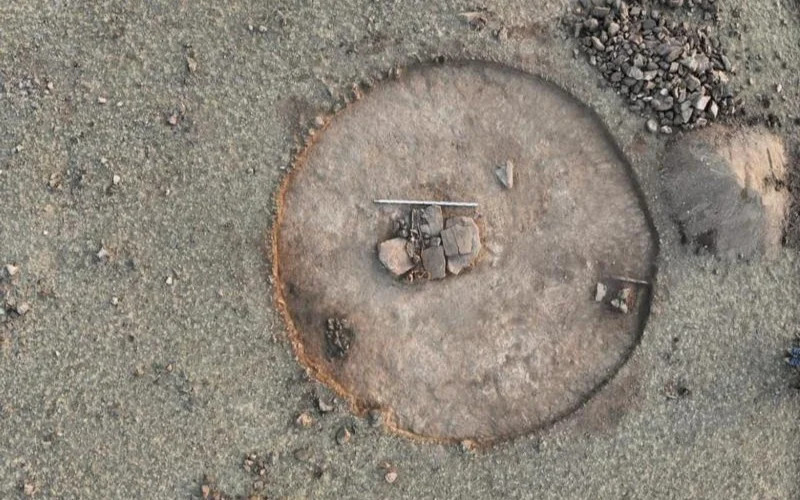ASTANA – New archaeological discoveries across Kazakhstan have revealed centuries-old civilizations, highlighting the region’s pivotal role as a cultural and trade hub between East and West. From Seljuk-era ceramics in the medieval city of Saraishyk to gold jewelry from the Saka and Wusun periods, these findings span vast geographies and eras.
Saraishyk: a crossroads of medieval trade
Excavations in the Atyrau Region have uncovered rare Seljuk-style ceramics and fragments of Chinese celadon porcelain in the ancient city of Saraishyk, reported 24.kz news outlet.
Turkish scholars proved in the late 1950s that a major trade center, Kubadabad, existed in Anatolia before the Mongol invasion of 1243. Caravans arrived there from China, Persia, and the Kipchak steppes.
Turkish researcher Muharrem Çeken noted that Saraishyk maintained trade ties with China, Anatolia, Byzantium and Khwarezm during the Golden Horde era. The discovery of ceramic pipes and a complex water supply system at the site suggests a high level of urban infrastructure.
“The architecture of cities along the Great Silk Road shares many common features. It has been proven that as early as the Middle Ages, Seljuk palaces used ceramic pipes for drinking water and sewage systems. Fragments of similar systems have now been found in Saraishyk,” he said.
Russian archaeologist Vyacheslav Plakhov added that the diversity of artifacts, ranging from Chinese porcelain to goods associated with the Crimean coast, demonstrates the city’s integration into extensive trade and cultural networks.
Experts now describe Saraishyk not merely as a trading post but as a “golden bridge” between East and West. Turkish researchers are expected to join the next phase of excavations later this year.
Karaganda Region: an untouched Iron Age burial unveiled
In the Shet district of the Karaganda Region, archaeologists from Buketov Karaganda University discovered a remarkably preserved early Iron Age burial in the Taldy historical and archaeological park, according to Kazinform.
The site features a Korgantas-type burial complex, a form of stone-mound grave associated with Early Iron Age nomadic cultures, containing a skeleton in a supine position, oxidized iron tools, and three skulls of small livestock.
“This type of burial is rare in our region, and importantly, the burial site remains undisturbed,” he said.
According to researchers, the burial was placed later on top of an older Bronze Age stone tomb and is tentatively dated to between the 4th and 1st centuries BCE, pending further analysis.
The Taldy valley, home to over 200 archaeological monuments, including a well-known steppe pyramid, continues to yield insights into the region’s nomadic heritage. Excavations are supported by the regional department of culture and are set to continue through next year.
Almaty Region: Saka and Wusun gold unearthed
In the Uygur district of the Almaty Region, archaeologists from Al-Farabi Kazakh National University have unearthed an array of gold ornaments dating back to the Early Iron Age. Among the most significant finds is an eight-gram gold ring bearing a composite image interpreted as a lion’s face, a woman’s face, or even a bull or ram, symbols that held important meanings for ancient tribes.
Excavations were carried out at the Togyzbulak-1 and Togyzbulak-2 cemeteries, which contain over 50 burial mounds. Items found in the third and fourth mounds include ceramic vessels, iron tools, gold plates, a gold chain fragment, and human remains. According to the Ministry of Science and Higher Education, assemblages uncovered at these burial sites date back to the Early Iron Age and confirm that the territory of today’s Uygur district was one of the centers of Saka culture.
Deputy akim (mayor) of the Uygur district, Erasyl Tolymbekuly, noted that the site, located 10-12 kilometers from Chundzha, a nearby settlement in the Almaty Region known for its historical and geographical significance, may also contain elements from the Wusun culture, dating back to the 2nd century BCE.
“Archaeologists discovered a ring cast from a gold ingot, featuring a design where one can discern a human face. They also uncovered various gold ornaments resembling elements of the Golden Man’s attire, along with fragments of ancient gold chains,” he said.
Tolymbekuly added that ongoing excavations are taking place in nearby areas, including Chundzha, Charyn National Park, and surrounding burial grounds. Scholars are also considering the hypothesis that Chigucheng, the presumed capital of the Wusuns, may have been located near the Sarytogai area in the Charyn ash grove.
